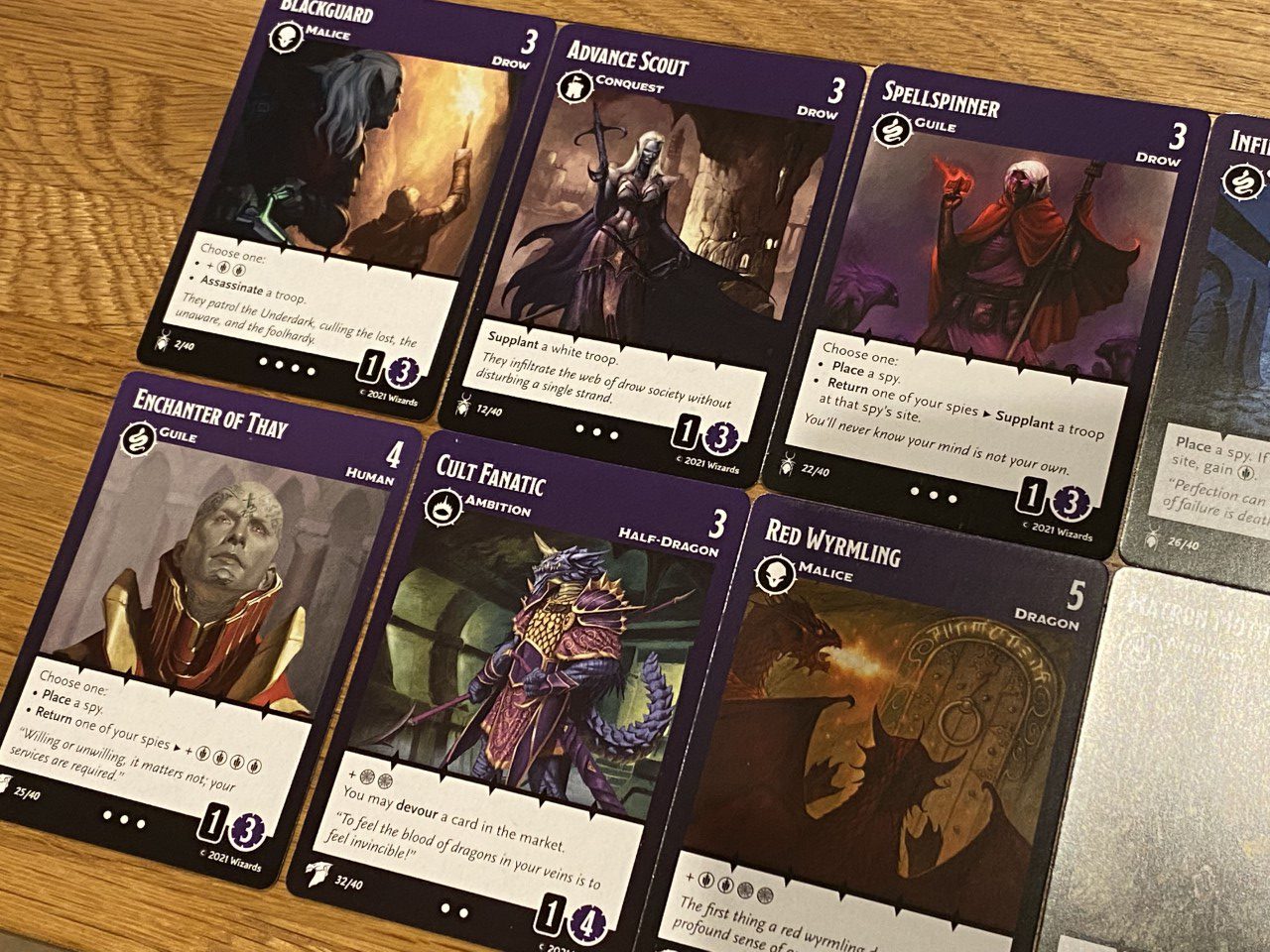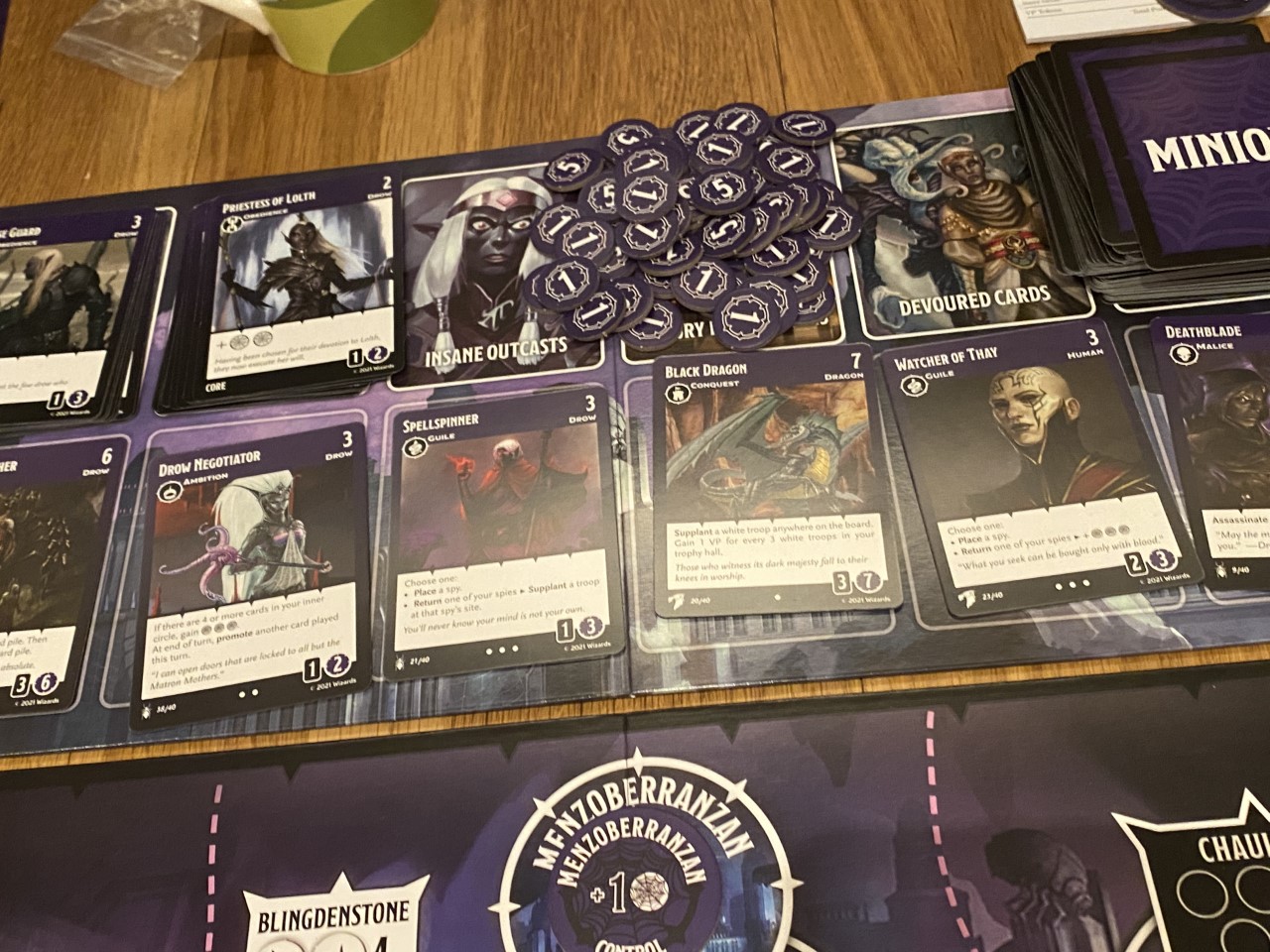Because board games are usually printed in limited numbers of perhaps up to a few thousand (for a standard retail release) there can be a big difference between versions when a reprint comes several years later. In the case of Tyrants of the Underdark, first published in 2016 and now reprinted in late 2021, that statement couldn’t be more accurate.
Both versions come from Gale Force Nine, with the original game including four “half-decks” (which I’ll cover in detail soon) and a load of plastic miniatures to denote the player’s presence on the board. The news for players looking to purchase the 2021 version is both good and bad. On the plus side, the new version includes six half-decks, including two which were released as an expansion for the original game, however in this later version, the plastic miniatures are replaced with very small, quite fiddly coloured tokens.

Aside from these cosmetic aspects, the main game is unchanged. It is possible that there are some minor rules tweaks, changes and clarifications, but without a clear comparison list provided by the publisher I would struggle to pick those out. What I can tell you (having never played the older version) is that Tyrants of the Underdark offers a smooth, super-clean, and really enjoyable overall experience.
Summarised in a single paragraph, Tyrants of the Underdark is a two to four player competitive game that tasks the players with taking control of Dungeons & Dragons titular Underdark — the realm that sits literally below the surface and offers sanctuary to only the darkest creatures and denizens of the D&D universe. To do this, players will place troops (and assassinate those of their enemies), use spies to get behind enemy lines, and vye for control of the most powerful regions.

What makes this process a little bit more unique and interesting than your average area control game is the way that players build a deck and use cards in their hand to manage their own faction. Each player starts with the same ten cards (Soldiers and Nobles) and they will use their Nobles initially to generate influence which can then be used to buy new cards from a shared market. Soldiers, on the other hand, grant power, which allows the placement of troops (or assassination if you have enough).
With just two simple resources to manage, players are eased gently into the mechanical flow of the game. They’ll draw five hands and play them all at first, with typical early turns involving adding one or two troops to the board, and then using influence to buy one or at most two relatively cheap cards.

By the mid game, the cards will do much more interesting things and the players will likely have expanded their influence on the board to the point where they are beginning to contend with each other. This contention is initially kept in check by white pieces which begin on the board and act merely to provide a barrier between starting locations.
A typical mid-game turn might involve playing a full hand of five cards including only those that have been bought in earlier rounds. These cards are often powerful — maybe you will place a spy somewhere, then withdraw one (and gain four power for doing so) then add three troops, then assassinate an enemy and gain points for it. You’ll finish a turn like this with a card that might allow you to promote a card — which is another of Tyrants of the Underdark’s party tricks.

Promotion is a hugely interesting mechanic, and it turns the normal flow of a deck builder on its head. It’s not unusual for games like this to have a keyword that removes weaker cards from your deck (typically just out of the game) but in Tyrants of the Underdark, players promote cards to their inner circle — removing them from circulation (meaning they can’t be used) but in almost all cases, massively increasing their end game points value.
Now, all of this flow is varied massively by which of the half-decks you use. The game instructs the players to choose any two from the six available, and whilst the (recommended) starting decks of Drow and Dragons are relatively straightforward, other more advanced decks (like Elementals or Demons) introduce much more complex strategies and synergies that change things a lot. Different combinations of these decks offer even more opportunity for fun and games.

The only downside to Tyrants of the Underdark really is those tokens, which I found to be too small and very “cheap” feeling, which wasn’t helped by the fact that my copy seemed to have a slightly off-centre printing. These things happen and given the low price point (currently under £30) for Tyrants of the Underdark, the use of tokens rather than miniatures is understandable.
Overall, Tyrants of the Underdark is a really, really fun game that offers tons of variety in a single box, as well as an accessible ruleset and a really low ramp for new players to climb up. It’s a very confrontational game, and your “best” turns come often at the expense of others, but as far as area control goes, that’s usually par for the course. For me, Tyrants of the Underdark is a superb addition to my game shelf and I really must find space for it.
You can get a copy of Tyrants of the Underdark from your friendly local game shop, or by checking BoardGamePrices.
A basically Euro-like territory control game augmented with deckbuilding and a multi-prong victory point system.
Hey Erik, yeah more or less – I would suggest it’s area control with a strong deckbuilding element at its heart. The points aspect is very much a consequence of either control or deckbuilding, but the game does a good job of “forcing” the players to interact with each other on the board, because otherwise runaway leaders will emerge. This means you can’t just focus on the deckbuilding part alone.
Have you tried Dune: Imperium by any chance?